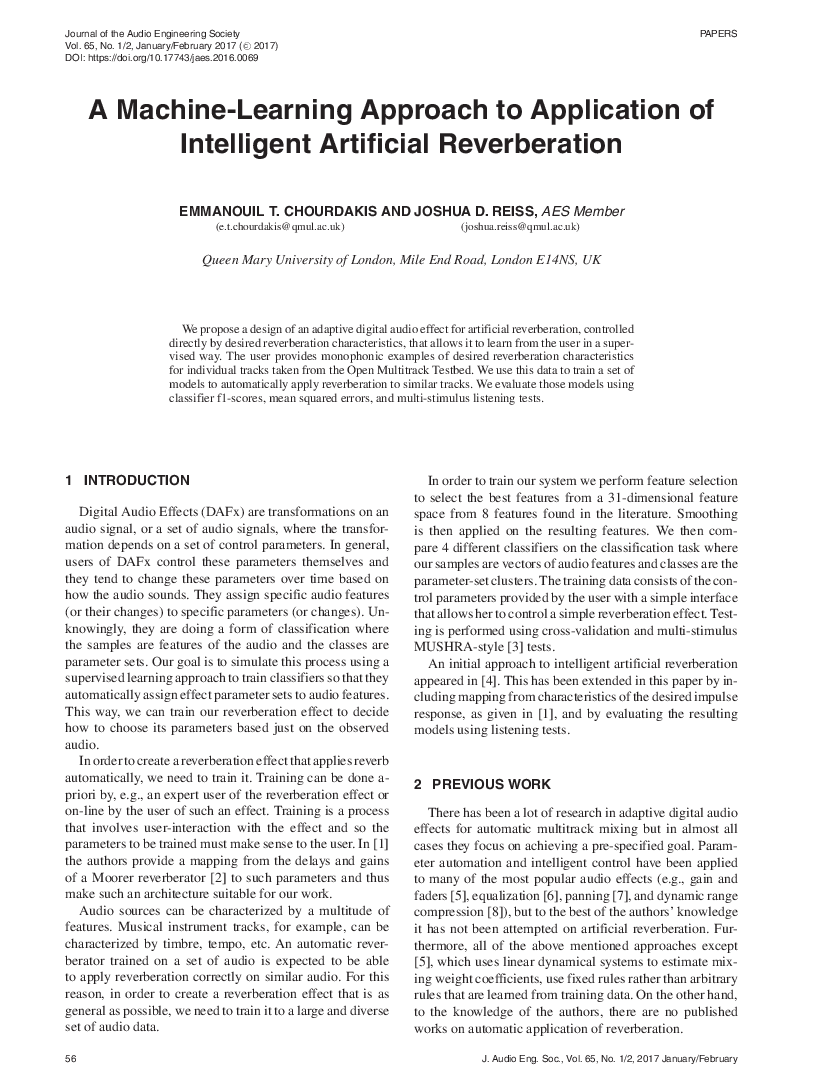Home / Publications / E-library page
You are currently logged in as an
Institutional Subscriber.
If you would like to logout,
please click on the button below.
Home / Publications / E-library page
Only AES members and Institutional Journal Subscribers can download
Digital audio effects, such as adding artificial reverberation, are actually transformations on an audio signal, where the transformation depends on a set of control parameters. Users change parameters over time based on the resulting perceived sound. This research simulates the process of automating the parameters using supervised learning to train classifiers so that they automatically assign effect parameter sets to audio features. Training can be done a-priori, as for example, by an expert user of the reverberation effects, or online by the user of such an effect. An automatic reverberator trained on a set of audio is expected to be able to apply reverberation correctly on similar audio defined by such properties as timbre, tempo, etc. For this reason, in order to create a reverberation effect that is as general as possible, training requires a large and diverse set of audio data. In one investigation, the user provides monophonic examples of desired reverberation characteristics for individual tracks taken from the Open Multitrack Testbed. This data was used to train a set of models that will automatically apply reverberation to similar tracks. The model was evaluated using classifier f1-scores, mean squared errors, and multistimulus listening tests. The best features from a 31-dimensional feature space were used.
Author (s): Chourdakis, Emmanouil T.; Reiss, Joshua D.
Affiliation:
Queen Mary University of London, Mile End Road, London, UK
(See document for exact affiliation information.)
Publication Date:
2017-01-06
Import into BibTeX
Permalink: https://aes2.org/publications/elibrary-page/?id=18543
(250KB)
Click to purchase paper as a non-member or login as an AES member. If your company or school subscribes to the E-Library then switch to the institutional version. If you are not an AES member Join the AES. If you need to check your member status, login to the Member Portal.

Chourdakis, Emmanouil T.; Reiss, Joshua D.; 2017; A Machine-Learning Approach to Application of Intelligent Artificial Reverberation [PDF]; Queen Mary University of London, Mile End Road, London, UK; Paper ; Available from: https://aes2.org/publications/elibrary-page/?id=18543
Chourdakis, Emmanouil T.; Reiss, Joshua D.; A Machine-Learning Approach to Application of Intelligent Artificial Reverberation [PDF]; Queen Mary University of London, Mile End Road, London, UK; Paper ; 2017 Available: https://aes2.org/publications/elibrary-page/?id=18543
@article{chourdakis2017a,
author={chourdakis emmanouil t. and reiss joshua d.},
journal={journal of the audio engineering society},
title={a machine-learning approach to application of intelligent artificial reverberation},
year={2017},
volume={65},
issue={1/2},
pages={56-65},
month={january},}